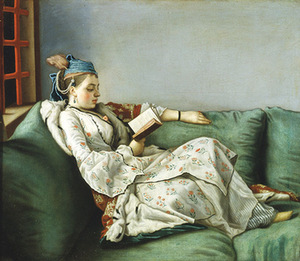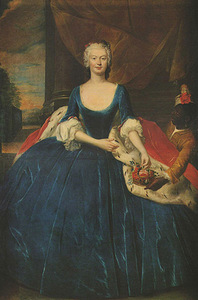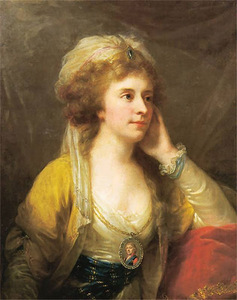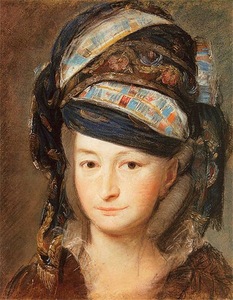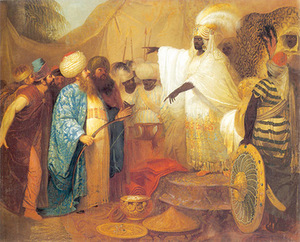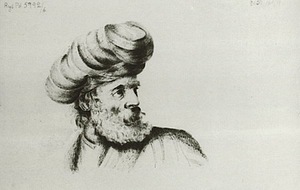Orientalism in painting - Turkish fashion conquers Europe (part 1) 4
In brief: Term orientalism in literature describes the culture common to the Middle and Near East and South Asia, which Europe tries to mimic. In the series of articles Marius Vyšniauskas presents the influence of orientalism to the art of Western and Lithuanian art.
Turkish fashion settled in Europe in the 16th century and lasted until the 19th. However, it did not have any links to historical events in the East but was rather about the European fantasies about the Eastern luxury, which were livened by the stories of ambassadors, about rich and mystical customs and unusual fashions. Men's minds where occupied with the stories about the Sultan's harem full of young lustful women ready to satisfy any desire. It is not surprising that the portraits in Europe feature so many aristocrats wearing turbans and feathers, smoking hookah in harem imitating places, with black people serving them.
Meanwhile, what did the largest European state at the time - the Republic of Both Nations - thought of the new style? Our country was exposed to the East already in the ancient times, therefore the exotic costume in painting emerged during the Middle Ages. Firstly, it was a Byzantine fashion. It is not known when the Byzantine type of costume, which had nothing to do with a local daily clothing and, most probably, was worn as an outfit for celebratory occasions by highest local feudal lords appeared in Lithuania. Most probably it reached our land around the 14th century or earlier, through Russia, when the influence of the Eastern culture increased in the Grand Duchy.
Oriental theme was also encouraged by Literature, for example Daniel Defoe, Roxana: The Fortunate Mistress, (1724) whose heroine liked to dress in a Turkish manner. But most likely, Lithuanians had read or at least had heard of our citizen - Regina Salomėja Ruseckaitė-Pilštyniova (1718–1760), who had lived in the sultan's harem. There is not much information about this woman, but it is clear that she was married to the optician and doctor Jokūbas Halpiras, with whom she left for Istanbul. There she had learned to treat and after a few years she went back there and became the doctor of sultan’s harem.
Yet, portrait a la turque, in our country, where more commonly of women's, who wore refined turbans, bright color fabrics, translucent veils and sat, leaning on the cushions, et al. Although, European and Eastern styles where thoroughly combined as in the West, for example - turban was tied on the powdered wig. The spirit of the painting is perfectly conveyed by the portraitists: Kazimieras Voinovskis (1772–1812) and Johann Baptist von Lampi der Ältere, 1751–1830).
Oriental theme plays, perhaps, the most important role in the works of Lithuanian painters Pranciškus Smuglevičius (1745–1807) and Jonas Rustemas (1762–1835).Since the latter has left a huge artistic legacy, this text will be limited only to his sketches and cards. In P. Smuglevičius painting two large historical canvases and a few portraits are dedicated to orientalism.
The subjects of the works are based on Herodotus History. They are illustrative and multifigured. Smuglevičius gladly uses the late baroque effects: oriental colorfulness, comfort, exotic luxury of clothing and weapons. Especially richly painted are the clothes and oriental presents of the characters in the painting "Persian messengers to the king of Ethiopia."
Finally, nothing links Lithuania, so closely, to Turkey like J. Rustemas, who’s painting and sketches feature orientalism widely. Even the origins of the painter pose many unanswered questions, because historians have not yet checked the rich material in the Istanbul archives. Official sources claim that J. Rustemas was born in Constantinople, Christian populated suburb of Peroj (cur. Beyoğlu), located in the European part of town.
Bearded Turks and black people that appear in the drawings of J. Rustemas, most probably come from the memories of the manor. Although, it is possible to assume, looking at the sketch of "Slave Sale" that this scene may have been witnessed by the author in the Ottoman Empire. Looking at the drawings of the painter we can see many scenes of a Turkish everyday life: Turkish men drinking tea, smoking long pipes, camel caravans, dozens of portraits of turban-wearing men and women, who are often decorated in a European fashion.
